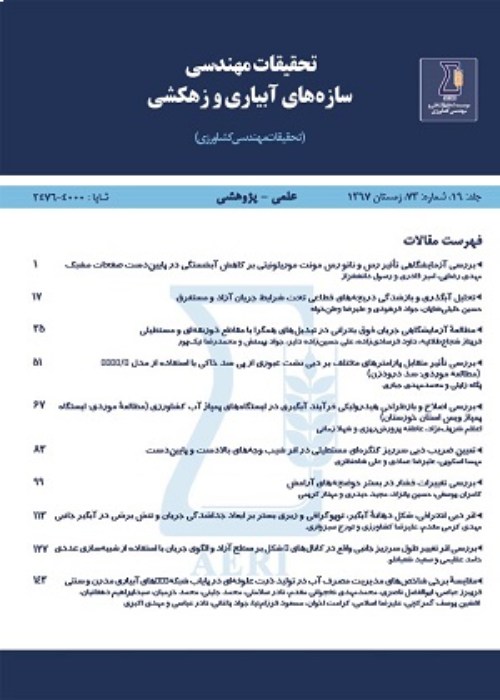Investigating the Effect of Changes in Agricultural Training and Extension Parameters on the Subsystems of the Chain of Water, Food, and Energy Resources in the Irrigation Networks Management(Case study: Qazvin Irrigation Network)
In the quantitative model development of the Nexus chain within the boundaries of irrigation networks, the role of social parameters is as much important as technical parameters if it is not higher. The social parameter’s role is essential in the explanation, definition, and description of the governing equations. The social parameters explain many systemic archetypes and become the balancing or reinforcing factor of some system loops. Of course, the main goal of extension programs is not limited to agricultural development; Rather, it aims to solve the three basic problems of third world rural communities, i.e. weak production, lack of equality in income distribution and lack of participation of villagers in social activities, so as to pave the way to achieve sustainable rural development in all its dimensions and elements. Nevertheless, although sometimes agricultural education and extension programs are considered ineffective and undesirable; But it cannot be ignored in the present and future development of rural areas.
Agricultural education and extension factors are the parameters that affect technical parameters in several aspects. These factors affect the cultivation pattern, method of water use, amount of required water, and irrigation management. The conceptual and quantitative model of the Nexus chain in the boundaries of the Qazvin irrigation network is developed. In addition to several technical relevant parameters in the Nexus chain, the agriculture extension is considered as well. The effects of agriculture extension parameters were investigated on the three integrated systemic archetypes defined in the model (a subsystem of "limit to growth" of agricultural expansion, "shifting the burden" of groundwater resources problem and "fixes that backfire" of development of arranged delivery).
• According to the extraction of the available historical education data in the last twenty years from the sites affiliated with the Ministry of Agriculture, the equations in the three subsystems were calculated by multivariable linear regression and curve regression.
The model was run for the years 2005 to 2016. Verification and validation tests were performed for the model and its results were interpreted for the Nexus index. It should be noted that all the input data in the model were entered into the model in a standardized way and the results between zero to one were calculated in a dimensionless manner. Nexus index is a linear combination of 8 partial indices in Qazvin irrigation network: water productivity in food, surface productivity in food, energy efficiency in food, economic productivity of food, economic productivity of water, economic productivity of energy, food production index in the network relative to the province and the index of the amount of water delivered to the water demanded. Because each part of the training was effective in a different variable; Therefore, the amount of changes in that variable was observed and their changes were recorded, and finally, in loading the model during the years of implementation of the model, the amount of the Nexus index, which was a combination of all three trainings; It was observed that they are shown in the diagrams of figures 6 to 8. and figure 9 shows changes on Nexus index in modelling years.
• The model was set for the coming years (by 2031). For this purpose, all inputs of the model were calibrated until the aforementioned year. By implementing the model, it is possible to monitor the effects of training on key indicators and finally the nexus index and study their effectiveness. Diagrams 9 to 11 show the impact of the continuation of the current trend in the farmers' training system on the vital parameters of the Nexus chain in Qazvin irrigation network. Also, the diagram in Figure 12 shows the effect of the downward trend in the education system on the trend of the Nexus index. It should be noted that the water productivity index reflects the training parameter in the direction of reviving water resources, and the index of the ratio of delivered water to the requested water reflects the network's utility index, which itself reflects the adjustment of the water demand from the network and ultimately reflects water storage in Qazvin network, and finally, the index of the ratio of agricultural products produced in the network to its similar amount in the province reflects the training parameter in line with the method and pattern of cultivation in the irrigation network.
The existing relationships in these interactions as well as the amount of their variations in the differential equations of each subsystem indicate the effectiveness of the agricultural extension activities on the subsystems. According to the developed regression equations and considering the effect of balancing extension parameters, it is expected that the increasing extensional activities as a policy lever will stop or at least balance the decreasing utility and weakening performance of the irrigation system.
- حق عضویت دریافتی صرف حمایت از نشریات عضو و نگهداری، تکمیل و توسعه مگیران میشود.
- پرداخت حق اشتراک و دانلود مقالات اجازه بازنشر آن در سایر رسانههای چاپی و دیجیتال را به کاربر نمیدهد.



